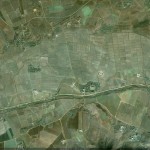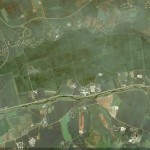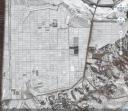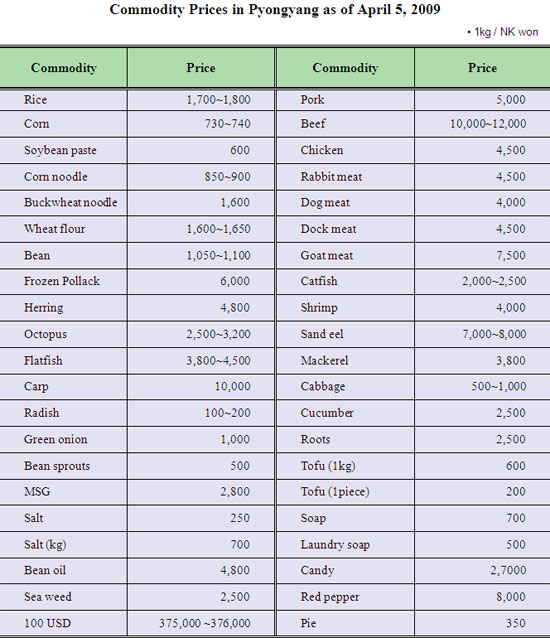For at least a decade the DPRK has been rezoning state-owned agricultural land into standard grids. Here is a good example of the policy as seen from Google Earth (Ryokpho, Pyongyang):


Before (2000-11-5) After (2005-8-5)
The Handure Plain is one of the most “popular” areas where this policy has been carried out:

Here are some KCNA stories about the policy:
Rural Community of Korea Conspicuous with True Feature of Socialism
Pyongyang, July 6 [2009](KCNA) — The three revolutions, ideological, technical and cultural, have been pushed ahead and the assistance to and leadership over the countryside by the government stepped up, making it possible to assimilate the peasantry to the working class and industrialize agriculture rapidly and change the looks of the countryside day by day.
The fields under cultivation have been standardized like a paduk (go) board and unique gravity-fed waterways and many dwelling houses have been constructed across the country to convert the countryside into a socialist fairyland good to live in.
Typical of such model farms are the Migok Co-op Farm in Sariwon City, North Hwanghae Province, the Sinam Co-op Farm in Ryongchon County, North Phyongan Province, the Chongsan Co-op Farm in Kangso County, South Phyongan Province and the Samjigang Co-op Farm in Jaeryong County, South Hwanghae Province and others.
The Migok Co-op Farm has constructed dwelling houses in tiers so as to see the vast field and the road leads to each block and each house. A large orchard has been arranged in front of the village and a resting site built on the hill covered with forests.
Wonderful is the landscape of the Ryongchon Plain in North Phyongan Province where life-giving water is flowing along the Paekma-Cholsan Waterway and rice plants are growing well in the standardized paddy fields.
Poman-ri, Sohung County, North Hwanghae Province, was once an out-of-the-way place with nothing to show except wild geese flying over it. But it, with a fishing farm in front of it and a forest of fruit trees in the rear, is now called one of the eight beautiful spots in the Songun era.
The horizon in Handure Plain and sea of potato-flowers at Taehongdan are also well known among the Koreans as ones of the above-said beautiful spots.
Electricity finds its way to all parts of the country and methane gas has been introduced to villages. Increasing in number are apricot tree villages and houses with many pear trees and persimmon trees where all sorts of flowers are in full bloom in spring and are pervaded with fruit aroma in summer and autumn.
While giving field guidance to the Tongbong Co-op Farm in Hamju County, South Hamgyong Province some time ago, General Secretary Kim Jong Il said that the farm village with cozy modern dwelling houses built on a sunny hillside and the co-op fields where green crops are swaying and farm machines are working look like a beautiful picture. He stressed that this is the laudable real feature of our socialist rural community.
Today the agricultural working people of Korea are all out to bring about a turn in the agricultural production with the responsibility for being in charge of the main front for the building of a great, prosperous and powerful nation.
Land leveling and rezoning completed
Pyongyang, May 16 [2000](KCNA) — The appearance of the land in North Phyongan Province, the northwestern part of the DPRK, has changed beyond recognition.
Not only the cooperative fields on the west coast from the 40 km-long Unjon plain and Pakchon plain to Ryongchon plain but the fields in in-between and mountainous areas from Kwanha plain in Nyongbyon and Handure plain in Thaechon to Hongnam plain in Uiju have turned into a vast expanse of fertile rice fields.
At least 50,000 hectares of rice fields were leveled and rezoned into standardized fields, each with a thousand or hundreds of Phyong (one Phyong is six square feet).
Thousands of hectares of land came under plough after the disappearance of a lot of ridges between paddies and swamps.
This great change in the land in north Phyongan province is a shining fruition of the gigantic and bold operation and plan of the great leader Kim Jong Il.
After finding great possibilities of increasing grain production at present in the land leveling and rezoning project, he wisely led the overall project. He set the target and stages of the project and clearly taught details of the project such as order of work to be done, the area of a field and even the issue of increasing the fertility of the rezoned fields. He saw to it that necessary forces and means for carrying out the project were sent there and it was undertaken as a movement involving the entire party and army and all the people.
As a result, the gigantic nature-transforming project was successfully completed under the difficult conditions where the province was hard pressed for everything.
Farming preparations are now in full swing in these fields.
Active land rezoning in North Phyongan Province
Pyongyang, November 30 [1999](KCNA) — Land rezoning is in full force in North Phyongan Province, northwestern part of Korea.
This project is being carried on the basis of the experience of last year’s land rezoning in Kangwon Province with the nation-wide attention and support. Through it, land covering more than 9,000 hectares was readjusted in the last one month.
In particular, the Kangwon provincial workers engaged in land improvement in Tongrim county removed the soil of 1.062 million cubic metres and rearranged 1,100 hectares of land in a short span of time by displaying mass heroism and devotion.
The workers from Pyongyang are now carrying out their daily quota 2 times that in October and have readjusted in the main the Handure plain in Thaechon county covering some 1,600 hectares, in 40 days or 50.
Thus as many as 13,000 fields were reduced to 3,000 fields and scores of hectares of cultivated land obtained.
The workers of Nampho city and North Hwanghae Province in charge of land rezoning in Nyongbyon and Ryongchon counties have achieved successes in their work by introducing working methods suited to the topographical peculiarities and soil conditions.
Thanks to the efforts of the workers from different provinces, the patches are being rearranged into the standardized fields, 1,000-1,500 Phyong each, one after another in every part of North Phyongan Province.
Unfortunately, these types of policies, even if successful, are only a third- or fourth-best option for feeding the people. These policies will never deliver the levels of food and wealth that are possible through opening up the country to investment and trade. Even without opening up to foreign investment/trade there are a number of policies the DPRK could enact to increase the efficiency of domestic food markets. It does not take a nobel prize winning economist to realize that the DPRK does not have a comparative advantage in food production.
UPDATE 1 : A valued reader recently made me aware of this informative article by Aidan Foster-Carter on the topic of land-rezoning (April 19, 2001):
TO ENGAGE or keep your distance? The administration of U.S. President George W. Bush has stirred up the Korean peninsula with its aloof, if confused, attitude to North Korea. But if Bush won’t engage, others will. The European Union, keen to be a player on the peninsula, will send Swedish Prime Minister Goran Persson to Pyongyang and Seoul in early May to discuss missiles and mediate.
The goal of engaging North Korea is to force an end to dangerous behaviour. This matter is not merely military. North Korea is now in its sixth year of a food crisis which has cost the lives of at least one million people. Flood and drought may have been the catalysts, but the root problem remains the doubly disastrous mix of rigid planning and the whim of leaders, where pet projects get the lion’s share of resources while less favoured regions and sectors are deprived.
The projects that paved the way for the food crisis included years of the overuse of inorganic fertilizers, which resulted in physical and chemical damage to soil; poorly planned hillside terracing; and the tearing down of forests to plant maize in the mountains. All this on top of the follies of collective farming, restricting private plots and markets.
North Korea is an ecological disaster, with the policies of Kim Jong Il and his father, late leader Kim Il Sung, to blame.
The follies continue. When Persson meets Kim Jong Il, let him ask about land rezoning, a project, more or less, to bulldoze North Korea flat and turn it into farmland. As the official Korean Central News Agency describes it, this is “a grand nature-harnessing work, to level at least 400,000 patches and remove 30,000 kilometres of ridges between rice fields which had been handed down through generations, and repartition them into standardized fields, each covering 1,000-1,500 pyong” (3,300 to 4,950 square metres). In Kim’s plan, 100,000 hectares are due for flattening; 27,000 hectares have already been flattened, “changing their appearance beyond recognition.”
In a speech to the annual Supreme People’s Assembly on April 5, Prime Minister Hong Song Nam made clear the plan was central to the coming year’s priority to “develop agriculture to resolve the food problem of the people.”
The policy was first carried out in marginal farming areas in Kangwon. Kim delivered a speech on the plan in January last year–from the middle of a field. Standing in shiny shoes amid a sea of mud, Kim saw scenic nooks and hillocks bulldozed flat, and rejoiced.
The policy has now spread to Hwanghae, the rice-basket province in the southwest that is crucial to national food supply. On March 25, Vice-Marshal Jo Myong Rok, the country’s top military official, who met President Bill Clinton at the White House last October, led a rally to promote more levelling before rice transplanting begins in May.
The theory: The creation of larger fields will allow the mechanization of agriculture and “free farmers from backbreaking work,” as Kim said in his speech, repeating one of his father’s favourite mantras. But mechanization is a pipe dream when the most hi-tech tool that most workers are armed with is a trowel, and tractors lie rusting for lack of fuel.
THE PROBLEM WITH KIM’S PLAN
The North Korean leader knows this, and has called for “strenuous efforts to repair [them] . . . as has been instructed before”. He has pledged to supply 160 imported tractors, although North Korea is desperately short of foreign exchange and this could hardly help the whole country, just a favoured few.
Kim admits that rezoning won’t raise yields immediately: “It is natural that the fertility of rezoned fields decreases,” he said. So “the soil must be enriched by the application of rich organic fertilizer through a mass movement.”
In fact, Kim has another motivation, and it has nothing to do with yields or labour-saving. “The fields in the Handure Plain . . . have been laid out well in regular shapes . . . . I am greatly satisfied,” he said in last year’s speech. “The plain has been completely transformed . . . . It would be impossible now for a former landowner to find his land, if he were to come with his land register to take his land back. The Handure Plain now looks like the land of a socialist state.” Intriguing that the Dear Leader thinks the landlords who fled in the 1940s, or their children, might come back and claim their own–as has happened in Eastern Europe since communist rule collapsed. Is he afraid?
Worse, in North Korea’s current conditions, the attempt to mechanize agriculture makes no economic sense. Experts including Marcus Noland of the Institute for International Economics in Washington say that Pyongyang should not even try to grow food. Instead, they say, it should seek comparative advantage in exporting light industrial goods, and import grain with the foreign exchange it earns, like South Korea.
As Persson knows, all who aid Pyongyang–and it’s a long list–have the right to insist that policies and practices which killed a million or more North Koreans cease. The EU has added leverage in that it may soon propose the establishment of diplomatic relations with Pyongyang. The UN World Food Programme has its largest operation in the world there, and though other organizations such as Oxfam have pulled out, the WFP and many other non-governmental organizations look to be there for the duration. Yet rather than voice their concerns and insist on tighter conditionality, they have been coy to challenge the irrational policies which caused the crisis and which still go on.
The solution found in China and Vietnam–the development of family farms and markets–offers a good model. In January, Kim hinted that new times demand new methods. In reality, informal markets are the only thing standing between most North Koreans and starvation. But to openly embrace them seems to be too much for Kim Jong Il.
As for land rezoning, it’s a new nadir. The fields of what is now North Korea were shaped by generations of human labour down the centuries, and bulldozing them is comparable to the Taliban’s irreversible destruction of Afghanistan’s prized Buddhas.
What can be addressed is the fact that seven-year-old North Koreans, according to data analyzed by Nicholas Eberstadt of the American Enterprise Institute, are 20 centimetres shorter and 10 kilogrammes lighter than their southern peers. Persson and Kim should have a lot to talk about.
UPDATE 2: I recently obtained a copy of the North Korean book, Songun Banner of Victory. It referred to the land rezoning program in Kangwon in purely revolutionary terms, stating it had “obliterated the last trace of feudal land ownership”.



